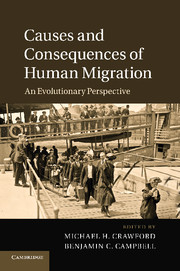Book contents
- Frontmatter
- Contents
- Contributors
- Preface
- 1 Perspectives on human migration: introduction
- Section 1 Theory
- 2 Genetic evidence concerning the origins and dispersals of modern humans
- 3 The biology of human migration: the ape that won’t commit?
- 4 Evolutionary basis of human migration
- 5 Evolutionary consequences of human migration: genetic, historic, and archaeological perspectives in the Caribbean and Aleutian Islands
- 6 Kin-structured migration and colonization
- 7 The role of diet and epigenetics in migration: molecular mechanisms underlying the consequences of change
- Section 2 Geography and migration
- Section 3 Overview
- Index
- References
2 - Genetic evidence concerning the origins and dispersals of modern humans
Published online by Cambridge University Press: 05 December 2012
- Frontmatter
- Contents
- Contributors
- Preface
- 1 Perspectives on human migration: introduction
- Section 1 Theory
- 2 Genetic evidence concerning the origins and dispersals of modern humans
- 3 The biology of human migration: the ape that won’t commit?
- 4 Evolutionary basis of human migration
- 5 Evolutionary consequences of human migration: genetic, historic, and archaeological perspectives in the Caribbean and Aleutian Islands
- 6 Kin-structured migration and colonization
- 7 The role of diet and epigenetics in migration: molecular mechanisms underlying the consequences of change
- Section 2 Geography and migration
- Section 3 Overview
- Index
- References
Summary
What does genetic evidence tell us about the origins and dispersals of our species, modern humans? This review updates the last review I wrote on this topic (Stoneking, 2008), but it is a substantial update and revision as there is much new information, especially from genome sequences of two extinct hominins, Neandertals (Green et al., 2010) and “Denisovans” (Reich et al., 2010), as well as from more sophisticated demographic analyses of genome-wide data (Reich et al., 2009; Wollstein et al., 2010). In particular, in contrast to previous reviews, we now have a model for human origins and dispersals that has been tested against dense genome-wide data.
Models for human origins
Over the years there have been many ideas about the origins of modern humans, but they basically all fall into the four main categories depicted in Figure 2.1. One of the earliest is the candelabra model, which prevailed for decades. According to this model, the common ancestor of human populations from the major regions of the Old World – Africa, Europe, Asia and Australasia – dates back to the late Miocene, perhaps as much as two million years ago. Since modern humans did not exist at that time, the transformation from our ancestors to modern humans would have occurred independently in four separate regions of the world, at more or less the same time. The candelabra model was most prominently associated with the anthropologist Carleton Coon (Coon, 1962), and fell out of favor when he used it to promote racist views. According to Coon, the transformation to modern humans occurred first in Europeans, and hence Europeans have had the most time to evolve from their “primitive”’ ancestry, while Africans were the last to transform into modern humans and therefore have had the least amount of time to shed their “primitive” ancestry – and in case you were wondering, Carleton Coon was indeed of European ancestry.
- Type
- Chapter
- Information
- Causes and Consequences of Human MigrationAn Evolutionary Perspective, pp. 11 - 20Publisher: Cambridge University PressPrint publication year: 2012



